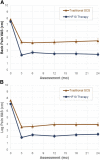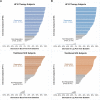Comparison of 10-kHz High-Frequency and Traditional Low-Frequency Spinal Cord Stimulation for the Treatment of Chronic Back and Leg Pain: 24-Month Results From a Multicenter, Randomized, Controlled Pivotal Trial
- PMID: 27584814
- PMCID: PMC5058646
- DOI: 10.1227/NEU.0000000000001418
Comparison of 10-kHz High-Frequency and Traditional Low-Frequency Spinal Cord Stimulation for the Treatment of Chronic Back and Leg Pain: 24-Month Results From a Multicenter, Randomized, Controlled Pivotal Trial
Abstract
Background: Pain relief with spinal cord stimulation (SCS) has focused historically on paresthesias overlapping chronically painful areas. A higher level evidence supports the use of SCS in treating leg pain than supports back pain, as it is difficult to achieve adequate paresthesia coverage, and then pain relief, in the low back region. In comparison, 10-kHz high-frequency (HF10 therapy) SCS therapy does not rely on intraoperative paresthesia mapping and remains paresthesia-free during therapy.
Objective: To compare long-term results of HF10 therapy and traditional low-frequency SCS.
Methods: A pragmatic randomized, controlled, pivotal trial with 24-month follow-up was conducted across 11 comprehensive pain treatment centers. Subjects had Visual Analog Scale scores of ≥5.0/10.0 cm for both back and leg pain, and were assigned randomly (1:1) to receive HF10 therapy or low-frequency SCS. The primary end point was a responder rate, defined as ≥50% back pain reduction from baseline at 3 months with a secondary end point at 12 months (previously reported). In this article, 24-month secondary results are presented. Non-inferiority was first assessed, and if demonstrated the results were tested for superiority.
Results: In the study, 198 subjects were randomized (101 HF10 therapy, 97 traditional SCS). One hundred seventy-one subjects (90 HF10 therapy, 81 traditional SCS) successfully completed a short-term trial and were implanted. Subjects averaged 54.9 ± 12.9 years old, 13.6 ± 11.3 years since diagnosis, 86.6% had back surgery, 88.3% were taking opioid analgesics. At 3 months, 84.5% of implanted HF10 therapy subjects were responders for back pain and 83.1% for leg pain, and 43.8% of traditional SCS subjects were responders for back pain and 55.5% for leg pain (P < .001 for both back and leg pain comparisons, non-inferiority and superiority). At 24 months, more subjects were responders to HF10 therapy than traditional SCS (back pain: 76.5% vs 49.3%; 27.2% difference, 95% CI, 10.1%-41.8%; P < .001 for non-inferiority and superiority; leg pain: 72.9% vs 49.3%; 23.6% difference, 95% CI, 5.9%-38.6%; P < .001 for non-inferiority and P = .003 for superiority). Also at 24 months, back pain decreased to a greater degree with HF10 therapy (66.9% ± 31.8%) than traditional SCS (41.1% ± 36.8%, P < .001 for non-inferiority and superiority). Leg pain also decreased to a greater degree with HF10 therapy (65.1% ± 36.0%) than traditional SCS (46.0% ± 40.4%, P < .001 for non-inferiority and P = .002 for superiority).
Conclusion: This study demonstrates long-term superiority of HF10 therapy compared with traditional SCS in treating both back and leg pain. The advantages of HF10 therapy are anticipated to impact the management of chronic pain patients substantially.
Abbreviations: IPG, implantable pulse generatorMCID, minimal clinically important differencePI, permanent implantODI, Oswestry Disability IndexSCS, spinal cord stimulationVAS, Visual Analog Scale.
Figures




Comment in
-
Letter: Comparison of 10-kHz High-Frequency and Traditional Low-Frequency Spinal Cord Stimulation for the Treatment of Chronic Back and Leg Pain: 24-Month Results From a Multicenter Randomized Controlled Pivotal Trial.Neurosurgery. 2017 Jan 1;80(1):E176-E177. doi: 10.1093/neuros/nyw018. Neurosurgery. 2017. PMID: 28362893 No abstract available.
References
-
- Schultz D, Webster L, Kosek P, Dar U, Tan Y, Sun M. Sensor-driven position-adaptive spinal cord stimulation for chronic pain. Pain Physician. 2012;15(1):1-12. - PubMed
-
- Parker JL, Karantonis DM, Single PS, Obradovic M, Cousins MJ. Compound action potentials recorded in the human spinal cord during neurostimulation for pain relief. Pain. 2012;153(3):593-601. - PubMed
-
- Kapural L, Doust MW, Gliner BE, et al. Novel 10 kHz high frequency therapy (HF10 therapy) is superior to traditional low frequency spinal cord stimulation for the treatment of chronic back and leg pain: the SENZA-RCT randomized controlled trial. Anesthesiology. 2015;123(4):851-860. - PubMed
-
- Van Buyten JP, Al-Kaisy A, Smet I, Palmisani S, Smith T. High-frequency spinal cord stimulation for the treatment of chronic back pain patients: results of a prospective multicenter european clinical study. Neuromodulation. 2013;16(1):59-66. - PubMed
Publication types
MeSH terms
LinkOut - more resources
Full Text Sources
Other Literature Sources
Medical

